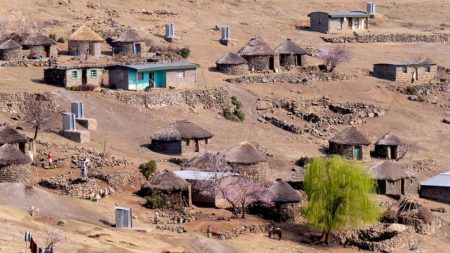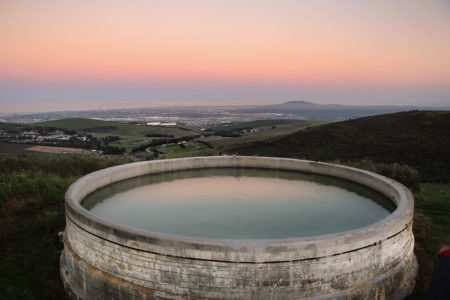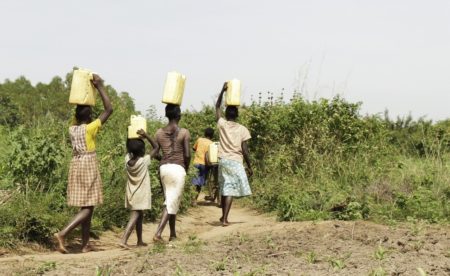Water Resources
South Africa is a water-scarce country receiving insufficient and unreliable rainfall. The country receives a mean annual precipitation of 497mm/year, almost 50% less than the global average of 860mm/year. The precipitation pattern is very unevenly distributed, with some areas receiving too much rain and others too little.
Precipitation is the main water supply. Water is collected in catchment areas and stored in 500 dams scattered throughout the country. The dams hold 37,000 million cubic metres of water when full. With sunny skies and high temperatures in summer, a lot of water is lost to evaporation. Drought and irregular rainfall also contribute to dam levels fluctuating from full to as little as 5% full.
The Katse Dam, situated in Lesotho, is part of the Lesotho Highlands Water Project and supplies water to South Africa and Hydropower to Lesotho. Most of the water is collected from melting snow in the Lesotho mountain system.
There are 10 small desalination plants in South Africa providing a small supplementary resource of water to the houses in the immediate vicinity of the plant.
The water and sanitation department has not really investigated methods to utilize geo-water, which is another available source of water in some areas of the country. Gift of the Givers, an NGO, that is involved in crisis assistance worldwide, has sunk boreholes in parts of the country to assist those in need. The Rahima Moosa Women and Children Hospital in South West Johannesburg is a case in point. This humanitarian organization also sank 15 boreholes in Makhanda to assist in the alleviation of the water problems in that town. But the Department of Water and Sanitation is hesitant to go down this road.
Access to Clean Water
This is a major problem in South Africa for a number of reasons. South Africa has a large rural population that does not have access to reticulated water. People have to walk long distances to draw water from rivers that are very often polluted by animals drinking from the same water, plastic thrown into the water and effluent from factories and surrounding farms. High levels of toxic chemicals, insecticides, herbicides and fertilisers enter rivers upstream.
A lack of investment in water or a lack of human capacity to satisfy the demand for water – even in places where water is abundant – can lead to poor access to clean water.
Urbanisation, deforestation, destruction of wetlands, mining – both legal and illegal – energy use, loadshedding and accidental spillage all account for a large percentage of water pollution.
Because of corruption and poor planning, South Africa’s Electricity Supply Commission is unable to provide enough electricity to meet the country’s needs. As a result, electricity is switched off according to a planned schedule at various times in the day for two to four hours at a time. The pump stations that pump water into city reservoirs are unable to pump sufficient water to these reservoirs resulting in many areas being left without water for days at a time. Tankers are meant to deliver water to affected areas, but very often poorer areas and informal settlements don’t get water. The water purification plants are also affected by loadshedding at times, affecting their ability to ensure clean water.
Fourteen years ago, the Nandoni Water Project was established in Giyani, Limpopo, to provide reticulated water to 55 villages in the area. This project is not yet completed (2023). Corruption is cited as the main reason for non-delivery of the project.
The desalination plant in Port Alfred, on the South East Cape coast, is not functioning at present because the contractor, who runs the plant, has not been paid. The money has either been misappropriated or used for something else.
Migration of rural populations to urban areas results in increasing demand for water in the cities which cannot always be met and which puts a strain on available resources. Gauteng’s population increased by 1.02 million between 2016 and 2021.
South Africa’s history of apartheid geospatial planning has resulted in many rural areas and small towns having either no access to water supply and sanitation services or severe backlogs in the provision of these services.
Access to consistent sources of clean water is crucial. Time spent gathering water or seeking safe sanitation accounts for a lot of lost economic opportunities. Access to safe water and sanitation at home turns time spent into time saved, giving families more time to pursue education and work opportunities that will help them break the cycle of poverty.
Without clean water people can’t stay healthy. If they can’t stay healthy, they can’t go to work or school, and can’t grow food and can’t provide for the family.
Gender Equality
The collection of water is usually done by women and young girls. This results in loss of time to study and attendance at school and loss of job opportunities for women as so much time is spent walking to the river, drawing water and walking home. If clean reticulated water was available in these rural areas women and girls would be empowered both socially and economically.
Mining
Pollution of water sources, caused by coal mining, poses a serious threat to both ground and surface water. Acid mine drainage, from gold mines in particular, forms a highly toxic fluid that mixes with rain water runoff, ground water, surface water and soil. Traces of this fluid have been found in water in and around Gauteng, where most of the abandoned gold mines are situated.
Coal plants require direct use of water at every step of their supply chain from the extraction and preparation of coal from mines, its incineration at coal-fired power stations, to the measures taken to control dust and pollution both at mines and power stations, and the disposal of the coal combustion by-products.
Eskom, the electricity supply facility, uses 10,000 litres of water per second to cool its turbines, control dust from the coal it uses to supply electricity and for a myriad of other functions.
Climate Change and Clean Water
In April 2022 torrential rains led to devastating floods in KwaZulu Natal, South Africa. Infrastructure, such as sewerage systems, roads, communication systems, water pipes and electricity supply was destroyed. Thousands of houses were destroyed by flood waters and mudslides and 461 known deaths were reported. To this day, 15th February, 2023, many people are still missing, presumed dead. Raw sewage flows into rivers and the sea, severely affecting the marine biome and contaminating river systems. It also flows in the streets of certain areas, posing a health hazard. A lot of areas still do not have potable water and many are living in makeshift accommodation or community centres. Many people, who holiday at the sea over the Christmas period, have reported to hospitals last December (2022), suffering from acute diarrhoea and vomiting as a result of exposure to contaminated sea or drinking water. Environmentalists say the severe flooding is a result of Climate Change.
Some Areas in the Eastern Cape have experienced drought conditions since 2015. Dams in these areas are either completely dry or have very low levels of water. Gqeberha (Port Elizabeth) municipality and surrounding areas have a 20% level of water in their supply dam and water is being severely rationed. Kariega residents have had no water for 3 months. Various water augmentation schemes are in the pipeline but have not become a reality. Reasons quoted are corruption, lack of hydrologists, hydro engineers, etc. Whatever the reason, the people are without safe drinking water. Graaff Reinet is in the same situation.
These are just two examples of a much bigger situation that needs to be addressed urgently. Political will, planning, employment of capable, qualified staff and the rooting out of corruption are all absolutely necessary to deal with the devastation of climate change and its effects on clean drinking water.
Sources: Helen Suzman Foundation, Greenpeace Africa, Personal experience
Marilyn Brown rsm
South African Province





